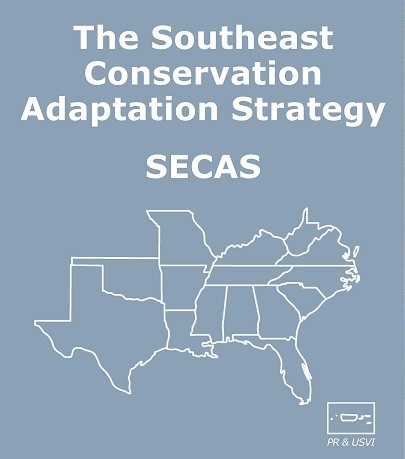Highlights from the March SECAS Steering Committee meeting

The SECAS Executive Steering Committee met on March 5, 2024, in Jackson, MS, to review and discuss the process for achieving a sustainable Southeastern landscape following the recent Southeast Landscape of the Future Summit, brief on SECAS staff efforts in support of State Wildlife Action Plans and other initiatives, decide on a SECAS logo, discuss working across regions with other regional collaboratives, and identify next steps. The SECAS Executive Steering Committee is a governing board of the partnership tasked with setting high-level priorities and direction. It includes Directors of five State Fish and Wildlife Agencies and the Regional Director of the U.S. Fish and Wildlife Service in the Southeast. The SECAS Steering Committee meeting coincided with the Southeastern Association of Fish and Wildlife Agencies (SEAFWA) Spring Director’s Meeting.
Every Steering Committee meeting is a chance to highlight all the amazing work that SECAS staff are doing in support of SECAS partners. During this meeting, staff showcased the work of the Blueprint User Support team in assisting partners with State Wildlife Action Plans, supporting a Caribbean Conservation Community of Practice, helping apply the new plant Regional Species of Greatest Conservation Need list, and supporting proposals to the America the Beautiful Challenge Grants, among others! We also highlighted how SECAS staff work in tandem with staff from other SEAFWA sub-committees, such as the Southeast Aquatic Resources Partnership and Minorities in Natural Resource Conservation. Ken Elowe and Gordon Meyers, from the Association of Fish and Wildlife Agencies (AFWA) joined the Steering Committee in the morning to talk about the great work of the AFWA Joint Task Force for Landscape Conservation (JTF) and how the regional collaboratives and JTF work together.
One of the main agenda items was to debrief on the recent Southeast Landscape of the Future Summit that was held in New Orleans, LA from February 27-29. Next month, I plan to share a blog dedicated to the Summit–in the meantime, this blog by Joshua Toran provides a fantastic summary. In short, the Summit provided a chance for the executive leadership of the public conservation institution (federal, state, and Tribal organizations) to come together to lay strong foundations for assessing shared drive and determination, map out dynamics of essential collaboration, identify fresh voices to include in our conversation, and reveal essential actions to move forward. Future efforts will involve other public sectors (e.g., transportation, education, energy, housing) as well as private sectors, including working lands and private landowners, non-governmental organizations, and others. The Steering Committee Members discussed their takeaways and recommendations, including the distinction between shared and compatible visions. There is support and interest in continuing to explore how the Southeast conservation institution can speak with one voice to help decide the Southeast landscape of the future.
A major focus of the meeting was how SECAS works together with other landscape-scale conservation initiatives to make a bigger impact both within and beyond our region. In the coming months, SECAS staff will be pursuing these three directives from the Executive Steering Committee:
- Scheduling a joint Steering Committee meeting with the Midwest Landscape Initiative, the Northeast Landscape Wildlife Conservation Committee, and potentially others
- Developing a Blueprint “how-to” guide to support other regions and initiatives that want to embark on similar efforts to identify conservation priorities, which will complement the existing Blueprint technical documentation with more of an emphasis on process and partnership
- Developing talking points on our collective effectiveness for landscape conservation across the Southeast, which will likely draw, in part, on the SECAS Goal Report to help measure our shared impact